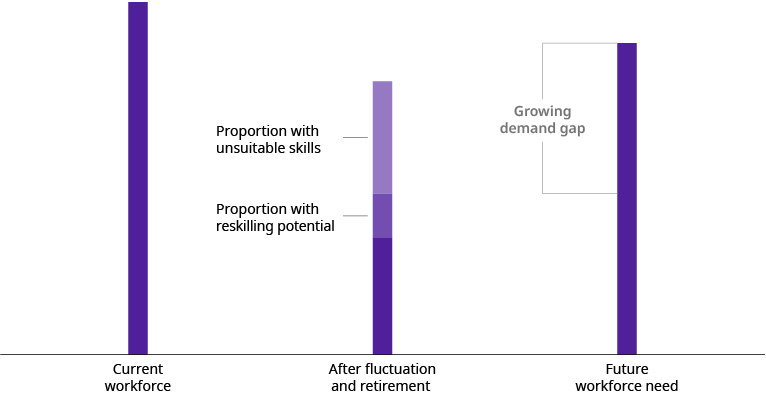This article was first published on December 3, 2020.
The COVID-19 pandemic is accelerating digitization in a range of areas. E-commerce adoption has been speeded up by about five years. Working from home has become the norm and will remain relevant after the pandemic. Use of the cloud is increasing across most sectors, and even automation is accelerating: Though past forecasts have overestimated its speed, more than two-thirds of business services corporations are planning to spend more on robotic process automation (RPA) software in 2020, according to one recent survey. All these shifts are generating extra demand for workers with tech and IT skills.
However, there is not enough tech talent available to fill the growing demand. Germany had 125,000 open positions in IT at the end of 2019, up 50 percent on the previous year. In the United States, employers needed an average of 66 days to hire a new tech employee in the first five months of 2019, up from 55 days in 2016 and compared with just 43 days for all types of hires. In 2020, 70 percent of European companies told one survey that they do not have a sufficient cybersecurity team, while the continent had an estimated shortage of 140,000 cybersecurity experts.
Temporary or external workers are helping firms to deal with the current uncertainties, as they can flexibly increase or decrease numbers according to business conditions. In 2020, 59 percent of hiring managers focused on freelancers, up from 42 percent in 2019 and 23 percent in 2017. But greater use of freelancers does not address the overall lack of skilled workers in the economy. Without more-fundamental action to address this, the gap will widen in the longer term.
Though more people worldwide are gaining technical expertise, much of the growth comes from China and India, which now produce almost two-thirds of the world’s STEM (science, technology, engineering, and mathematics) graduates. Many industrialized countries are aging and have low birthrates: The working population in Germany, for example, is forecast to decrease by 4 million, or 8 percent, over the next 10 years. And the country’s growing number of older people are, in general, not well suited to tech work: More than 80 percent of Germany’s over-55’s have IT skill gaps. By 2025, Germany is expected to have a shortage of some 280,000 people with STEM qualifications.
Though the skills shortage has been worsening for several years, the problem has recently been aggravated. COVID-19, while driving demand for tech skills, has also hindered firms’ efforts to attract specialized workers because of the travel restrictions introduced. We think there are three main strategies that can help corporations achieve better-skilled workforces.
Exhibit 1: Workforce development over time

Source: Oliver Wyman analysis
Use The Reskilling Momentum
Companies are increasingly rolling out reskilling programs, many of which are large-scale investments at the top of executive agendas. These programs avoid layoffs – and their financial costs and the damage to staff morale – as well as the subsequent competition for new tech hires.
Reskilling has an opportunity cost: Salaried employees do not carry out productive work during their training period. This is generally the highest cost of reskilling – more than that of a training course or an additional university degree – but the general economic downturn means that it is now declining. In some cases during the COVID crisis, governments have offered financial help to companies that put underutilized people in training instead of on subsidized furlough schemes. According to a recent LinkedIn Workplace Learning Report, sampling industries in 18 countries, 51 percent of companies are planning upskilling programs and 47 percent reskilling programs.
Learn From The Gig Economy
Firms can take lessons from the gig economy on how to become desirable places to work. First, many tech workers choose to freelance because of the flexibility: They have greater control over their schedules than traditional employees, and they can work from home. One motivation is that 48 percent of freelancers are caregivers to one or more family members; 76 percent of freelancing caregivers say that freelancing gives them more flexibility to be available for their families. In other cases, the freelance lifestyle is a preference: 74 percent of freelancers prefer working remotely to in a traditional office.
Second, skills advancement is among the top three reasons for employees to join, stay, or leave companies, according to the Mercer report 2020 Global Talent Trends. In the last six months, 59 percent of freelancers have participated in skills training, compared with 36 percent of traditional workers. So firms that want to attract freelancers should make learning and development a top priority. Many current programs are ineffective. Successful initiatives will leverage the latest technologies and delivery approaches, such as gamification. They will tailor constant education and training to individual staff members and will eventually embed a culture of learning in an organization. To track the benefits of the programs, the organization should actively measure their impact on development and employee value.
Rethink Global Footprint Design
Traditionally, many multinationals have designed their global footprints to benefit from labor-cost arbitrage. But this formula is dated for two reasons. Firstly, the global market mechanisms etermining the price of talent have significantly improved, so it is now similar regardless of location. Secondly, co-creating digital offerings and customer journeys often requires close collaboration with physical proximity to colleagues and clients.So firms should carefully weigh up the benefits of tapping high-quality, low-cost labor pools in different parts of the world and of achieving high productivity levels in their technology work groups. High productivity is typically driven by small teams collaborating intensely.








